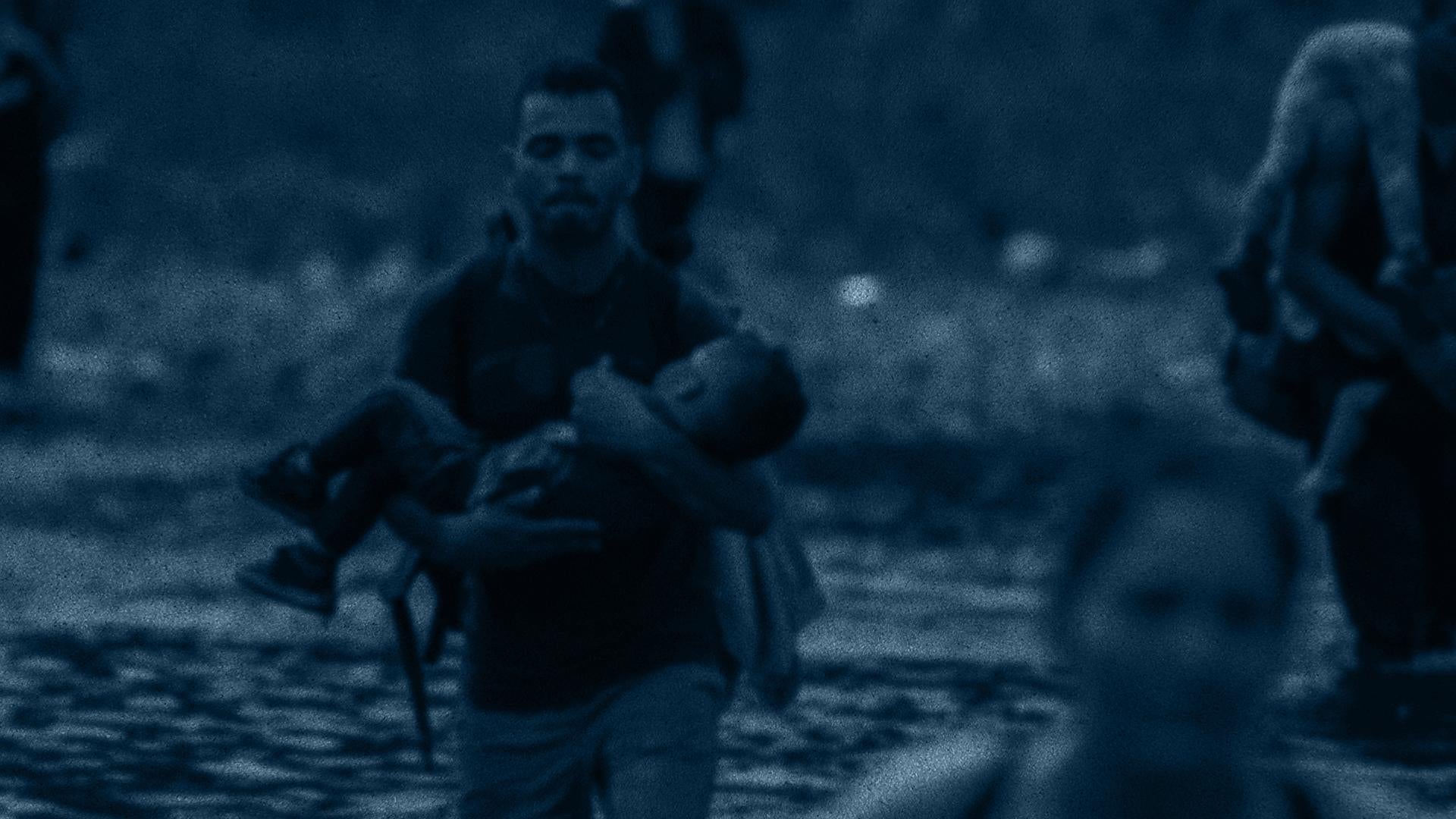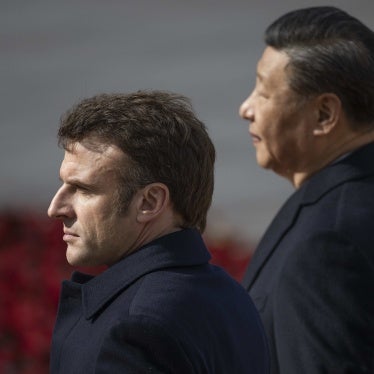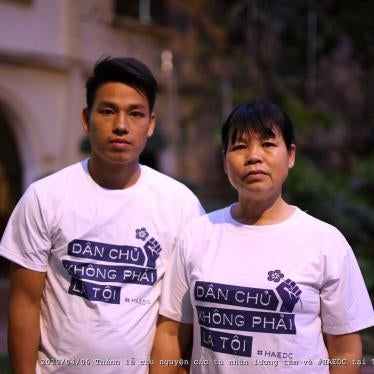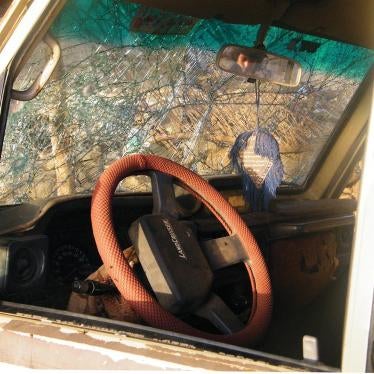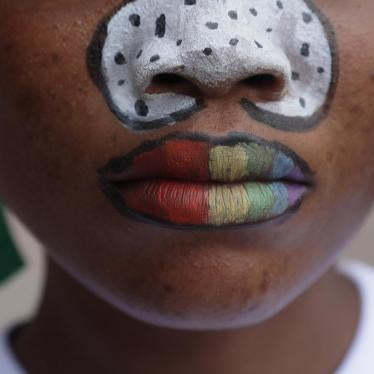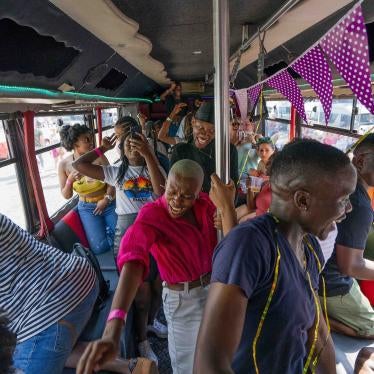Hillary Clinton
Secretary of State
U.S. Department of State
2201 C Street NW
Washington, DC 20520
Re: US strategy for supporting women’s rights in Afghanistan
Dear Secretary Clinton,
We write to ask you to take the lead in formulating a clear and public US strategy for promotion and protection of women’s rights in Afghanistan, and to urge other countries to join in this effort.
We recognize the commitment both you and your Ambassador for Global Women’s Issues, Melanne Verveer, have demonstrated to women’s rights in Afghanistan. We also recognize the large commitment of resources and energy by many others in the US government to promote and protect the rights of Afghan women and girls.
We believe, however, that overall US policy in Afghanistan does not adequately and consistently reflect the importance that you have rightly placed on protecting women’s rights. While the United States government as a whole has spent a great deal of time and resources creating security strategies for Afghanistan, women’s rights concerns have not in practice been fully integrated into these strategies.
Afghanistan presents a challenging and critical test of US efforts to support gender equality around the world. The December 2011 US “National Action Plan on Women Peace and Security,” the March 2012 Department of State guidance on “Promoting Gender Equality to Achieve our National Security and Foreign Policy Objectives,” and the new US “Strategy to Prevent and Respond to Gender-based Violence Globally” chart an ambitious and important path for the US in supporting women’s empowerment globally.
Nowhere will these efforts meet greater obstacles than in Afghanistan. To be sure, the last 10 years have brought some significant advances for Afghan women and girls, including in education, access to health care, freedom of movement, employment, and participation in public life.
However, Afghanistan maintains a dismal women’s rights record on many fronts, remaining one of the worst countries in the world to be a woman. Recent WHO, UNICEF, and World Bank reports and the Afghanistan Mortality Survey of 2010 show that maternal and infant mortality remain among the highest in the world. The Afghan government estimates that half of all girls still do not go to school and that very few complete high school. In many parts of the country, Human Rights Watch has found that many women and girls are not even free to leave their homes.
Afghan women and girls endure high levels of violence, both within and outside their homes. A 2008 Global Rights study found that over 87 percent of Afghan women experience at least one form of abuse in their lifetime. Forced marriage and underage marriage are endemic: a recent UNICEF study found that 20 percent of girls aged 15-19 were married, 46 percent of women aged 15-49 had married before age 18, and 7 percent of women are in polygamous marriages. Human Rights Watch research has determined that several hundred women and girls have been imprisoned for “moral crimes,” often simply for the act of fleeing domestic abuse.
Human Rights Watch and local women’s rights activists have consistently documented how women in public life routinely face threats, some of which have resulted in assassinations. Afghan President Hamid Karzai has proven to be an unreliable supporter of women’s rights, and constant pressure is required to prevent him and the Afghan government from backtracking on their domestic and international legal obligations to safeguard women’s rights.
A combination of different factors has resulted in enormous and increasing anxiety for Afghan women and girls. These include: transition of full security responsibilities to the Afghan government as international troops draw down; pressure to reach an agreement with the Taliban; fatigue with Afghanistan and the Afghan war among the US public; sharp reductions in the amount of US development assistance; and attempts by conservative politicians and other powerful opponents of women’s rights in Afghanistan to roll back progress already achieved. Altogether they have created a grave risk that women’s rights will come under increasing threat in coming years.
In the face of these pressures, the overwhelming sentiment that women’s rights activists express is of fear – fear that as the international community loses interest in Afghanistan, Afghan women and girls will find themselves abandoned and forced to relinquish the limited rights they have fought for and gained, at great cost, over the last decade.
Progress on women’s rights in Afghanistan has come about in large part because of the fearless efforts and hard work of Afghan women and girls – and Afghan men who are their allies. But this progress is exceedingly fragile and depends heavily on continuing international political pressure and support. Funding and other direct assistance from the US and other foreign donors has made the difference between life and death for many Afghan women and girls, and has been critical in supporting women’s rights advocates.
In spite of strong statements at the Tokyo Conference and elsewhere, however, the future of US assistance to women’s rights in Afghanistan remains too vague. This is therefore a crucial moment for the US government to go beyond speaking out about its commitment to women’s rights in Afghanistan and fulfill the promise of these statements through a detailed plan for providing US support for Afghan women and women’s rights organizations in the years ahead.
The US-Afghanistan Strategic Partnership Agreement (SPA) was an effort to send a clear message to Afghans and their neighbors that the US will not abandon Afghanistan after 2014. The SPA reaffirmed Afghanistan’s commitment to eliminate discrimination between citizens and reiterated its commitment to “ensure and advance the essential role of women in society, so that they may fully enjoy their economic, social, political, civil, and cultural rights,” but contained no corresponding plan for implementation of this commitment. The US explicitly committed to seeking funds on an annual basis beyond 2014 to support the training, equipping, advising, and sustaining of the Afghan National Security Forces, but neither in this SPA nor elsewhere is there a comparable funding commitment to protect women’s rights. Similarly, while the SPA details a range of bilateral measures and commitments on the security front, including the creation of a US-Afghanistan Working Group on Defense and Security, no similar structures or measures have been put in place to promote, protect, and fulfill women’s rights beyond 2014.
In spite of the importance that successive administrations have placed on the rights of Afghan women and girls, since 2001 no comparable strategy to protect women’s rights has been publicly articulated. We believe now is the time to do so, particularly in the lead-up to the security transition in 2014. Afghan women and girls need a strategic partnership agreement of their own that focuses specifically on the promotion and protection of their rights. We urge you to use your remaining time in office to formulate such a strategy and work to set US policy on a strong course for future years. We recommend a strategy based on the following themes – explained in detail in the attachment below – to protect women’s rights in Afghanistan in the difficult years ahead:
- Press the Afghan government at the highest political levels to proactively promote and protect women’s rights, and in particular press them to use women’s rights as a key indicator for measuring development and security.
- Ensure Afghanistan’s security strategy is focused on women as much as on soldiers and weapons.
- Organize and promote broad international support for this strategy.
Entrenching this strategy with the necessary political and economic resources would be an important legacy of your tenure as Secretary of State. A strategy with concrete commitments from the US that Afghan women can count on in the tough years that lie ahead for them and their country would send a clear message to President Karzai and other Afghan leaders that a key condition of continued US engagement in Afghanistan will be the Afghan government’s record on supporting and respecting women’s rights. Promoting this strategy will also motivate other countries to make similar commitments. By creating and publicizing such a plan, the US can play a leading role in rallying the global support necessary to ensure that the rights of women and girls in Afghanistan do not go backwards again.
Appended to this letter are recommendations for elements that could go into a new strategy to promote and protect women’s rights in Afghanistan.
Thank you for your consideration. We look forward to working with you to defend the rights of Afghan women and girls.
Yours sincerely,
Brad Adams
Executive Director
Asia Division
A Strategy for Women’s Rights in Afghanistan
The United States and other donor countries should create a strategy for supporting the rights of Afghan women and girls. The strategy should be public, long-term, and, to the greatest extent possible, quantifiable. The US and other donors should ensure accountability for implementing such a strategy by periodically measuring its progress and their own efforts, through appropriate benchmarks and indicators. To do this, we urge the US and other governments to:
1) Continue to press the Afghan government at the highest political levels to proactively promote and protect women’s rights and use women’s rights as a key indicator for measuring development and security.
The Afghans at greatest risk as the international community reduces its presence in Afghanistan are women and girls. The gains made in girls’ education and reducing maternal mortality have been some of the most important achievements since the end of Taliban rule 11 years ago. The participation of girls in education and women in the work force and in public life are integral to Afghanistan’s future economic and political development.
However, these gains face grave threats. President Karzai has long demonstrated that he is willing to bargain away women’s rights for political gain. When he wants to please the international community, he has taken strong positions such as supporting the National Action Plan for the Women of Afghanistan and adopting the Law on Elimination of Violence against Women. When it is more important to him to please those in Afghan society hostile to the rights of women, he takes positions like his endorsement of the Shia Personal Status Law and the Ulema Shura’s March 2012 guidelines for women that labeled women secondary to men, called for strict segregation of men and women, and condoned violence against women in some circumstances. President Karzai also has a record of appointing – and defending – high-ranking government officials whose actions are damaging to women’s rights. Recent examples of this include the statements of the minister of justice asserting that shelters for women cause immorality and prostitution and the insistence by the Supreme Court that “running away” by women and girls should be treated as a crime in spite of the fact that there is no basis for this in Afghan law.
The Afghan government’s inconsistent record on women’s rights means that it is critical for donors to consistently insist that President Karzai and his government comply with their international legal obligations to promote and protect women’s rights.
The US should join together with other key donor countries in complementing the provision of aid with forceful and constant political support for women’s rights at the highest levels, including in all discussions with President Karzai himself and other senior government officials and all high-level public statements by the US president (many Afghan women still comment on the omission of any reference to women in President Barack Obama’s December 2009 strategy speech on Afghanistan). The US should propose an ambassadorial level working group that will meet with President Karzai and other senior Afghan officials at least quarterly to discuss benchmarks and actions on women’s rights.
The US and other donors should send a strong and constant message from donors that continued support to Afghanistan depends on women’s rights progress with no backsliding. Some of the key issues the US and others should focus political pressure on include:
a) Prompt public responses to government actions and statements that violate Afghanistan’s obligations to women and girls
When President Karzai spoke out in favor of sexist and retrograde “guidelines” for women issued by the Ulema Council in March 2012, many Afghan women’s rights activists were distressed and surprised by the silence of the international community. US Secretary of State Hillary Clinton spoke directly with President Karzai about this issue and expressed her concerns, but the lack of a more public response by the US government and other international actors left many Afghan women wondering if the international community had already watered down its commitment to women’s rights in the country. Similar concerns were raised in June 2012 when President Karzai’s minister of justice, Habibullah Ghaleb, described women’s shelters as hosting “immorality and prostitution.”
We recognize that quiet diplomacy sometimes has advantages over public denunciations, but in the Afghanistan context, quiet diplomacy is not sufficient to support women’s rights. On the contrary, government officials and many women’s rights activists perceive silence on important issues by the US as a lack of interest in women’s rights not only from the US but also by the broader international community. Such omissions are seized upon by those in Afghanistan who oppose women’s rights and lead to losses for women and girls on the ground. Vocal and public international pressure, especially by the US, has played a critical role in encouraging the Afghanistan government to take women’s rights seriously.
Afghanistan’s obligations regarding women’s rights are well established under Afghan and international human rights law. When the president or other members of the Afghan government take actions or make statements that violate or express disregard for those obligations, we believe it important that the US government speaks out promptly, publicly, and forcefully.
b) Push for women-friendly leadership in key institutions
The US is by far the largest donor to Afghan institutions, including institutions that should play a crucial role in supporting women’s rights. The US and other donors will waste much of this investment if they do not complement aid efforts with political pressure to ensure that these institutions are led by senior Afghans with a willingness to adhere to Afghanistan’s legal obligations to women. Some of the institutions where this is particularly important include the Ministry of Women’s Affairs, the Ministry of Interior, the Ministry of Justice, the Attorney General’s Office, the Supreme Court, the Ministry of Education, the Ministry of Higher Education, and the Ministry of Public Health.
While not all of these institutions are plagued by leadership hostile to women’s rights, there are far too many examples of senior members of government undermining women. A few recent examples include the invasive vaginal searches of female visitors at Pul-i-Charkhi prison conducted by staff of the Ministry of Interior, the effort by the Ministry of Women’s Affairs to take over privately run shelters, the minister of justice’s blocking of reforms to family law, the Supreme Court’s instruction to judges to treat “running away” from home as a crime, and the claim by the minister of justice that immorality and prostitution is taking place in women’s shelters. We recognize that State Department officials and you in particular have pressed this issue, and that the US has limited ability to influence appointments within the government. Yet this will be one of the critical factors for women and girls in the future, and the US should make it policy at all levels and throughout all agencies to push for the appointment of senior officials who understand and are receptive to women’s rights concerns. US officials should also push for dismissal of officials who have engaged in discriminatory conduct against women or have refused to implement laws that protect women’s rights.
c) Ensure a central role for women in peace-building
The role of women in the peace-building process is of crucial importance, as recognized by UN Security Council Resolution 1325.[1] Yet Afghan women have had to repeatedly struggle, with very limited success, for a place at the table where key decisions are being made about Afghanistan’s future. The conspicuous absence of Afghan women at the NATO Summit in Chicago was just the latest example in a long line of exclusions and omissions. Security is not a subject that only affects men. The US should insist that all Afghan delegations attending US-supported meetings or events include a significant proportion of women. In addition, the US should press for strengthened representation, in both numbers and functions, of women on the High Peace Council as well as in any negotiations with the Taliban.
d) Press for enforcement of the Law on Elimination of Violence against Women
The 2009 Law on the Elimination of Violence against Women (EVAW Law) represented a landmark legislative step towards protecting Afghan women. Unfortunately, the law has largely gone unenforced, with few cases of violence against women investigated and prosecuted. Although President Karzai signed the EVAW law, he has failed to provide the leadership necessary for the law to be enforced. The US should make enforcement of the EVAW Law one of its top law enforcement priorities in discussion with Karzai and other senior Afghan government officials. It should also provide support for large-scale efforts at public awareness about the law.
By providing criminal penalties for common practices that previously were accepted or unpunished such as underage marriage, forced marriage, sale of women, rape, domestic abuse, and forced self-immolation, the EVAW Law has the potential to dramatically change the role of women in Afghan society. In order for the law to realize this potential, however, far greater effort must go into its enforcement. High-level political commitments from Karzai and key government officials, including the minister of interior and the attorney general, and pressure on the police and prosecutors to follow and enforce the law are crucial. The chief justice similarly has an important role to play in ensuring that the country’s judges appropriately apply the EVAW law.
The US has already made significant investment in supporting implementation of the EVAW, including through funding police family response units and specialized violence against women prosecution units. This investment, however, will be ineffectual without stronger political support for enforcement of the EVAW law from the Afghan government, as expressed in the July 2012 Tokyo Mutual Accountability Framework. The US should make this commitment a key priority in its discussions with Karzai and high-ranking Afghan officials in these institutions.
One of the key obstacles to enforcement of the EVAW Law is the difficulties Afghan women face in obtaining help from the police. Human Rights Watch has documented cases of women being raped by police officers, including in situations where the women made contact with police in order to report violence. Only 1 percent of Afghan police officers are female, in part because of resistance from men and the wider society, and because of security threats and sexual harassment faced by female police. Simply having female police officers will not solve the problem of violence against women in Afghanistan, but they are needed to enforce the EVAW Law. For instance, without female police officers, women are less likely to report crimes, given Afghanistan’s cultural context. As a major donor to the UN-administered Law and Order Trust Fund for Afghanistan (LOTFA), we urge the US to link its support for LOTFA to specific conditions regarding increased recruitment, retention, and support for female police officers and training on violence against women for all police officers in the Afghanistan National Police.
e) Make basic human rights for women a key funding priority
A long-term commitment is vital to funding services and programs necessary to support the basic rights of women and girls. Many schools, clinics, hospitals, legal services and shelters have directly facilitated progress for women in Afghanistan, but are resourced solely through international funding, often from the US. Until Afghanistan can afford to fund these services from its own sources, donors will need to provide large-scale assistance.
The US should not only maintain funding for essential services for women, but should provide new funding in key areas, including education and health care. We also encourage the US to continue and expand its already significant support for shelters for women and girls fleeing violence, legal services for women, and Afghan human rights organizations that promote women’s rights. One example of a wholly internationally funded program that protects women’s rights is shelters for women fleeing violence. The US funds the operating budget of a large proportion of existing shelters, which receive no Afghan government funding at all. While it is inevitable that many US-funded projects will be defunded as aid declines, protecting and continuing progress for women should be a key goal going forward, and tough decisions about where to cut funding should reflect this.[2]
Benchmarks should include increases in enrollment of girls in school, increases in the percentage of girls who complete high school, increases in the number of qualified teachers, and specific targets for improved participation in education by girls in provinces with low female educational achievement at present (such as in Kandahar). In the area of health care, the US should continue to support programming on women’s reproductive health, including funding surveys to assess progress on maternal health like the Afghanistan Mortality Survey 2010. Benchmarks should include substantial increases in the numbers of women receiving professional pre- and post-natal care, giving birth under the supervision of a doctor or professionally trained midwife, and women receiving other basic health services. In the area of violence against women, benchmarks should focus on increasing the total number of shelter beds available for women fleeing violence, provinces where such beds are available, prosecutions of batterers and rapists, and the availability of qualified lawyers and paralegals to assist women in civil legal matters such as divorce and other family law matters.
The US is one of the primary donors paying the salaries of Afghan police through LOTFA. The US and other donors should consider making a similar commitment to supporting workers in the education and health sectors. Support for salaries of essential education and healthcare workers, in a sustained and predictable manner, could make a huge difference in the years to come. Conversely, without key donors making this a priority, there is a great risk that buildings constructed by the US at great expense to serve as schools, clinics, and hospitals could sit empty for lack of staff.
2) Ensure the security strategy focuses on women as well as on security forces
The US should take the lead in monitoring and mitigating the impact of the security transition on women and girls. As the security transition moves forward, there needs to be careful attention to protecting women and girls at the community level. The US should work with the Afghan government, including the Afghan security forces, to develop special measures to protect women and girls, including targeted protection of girls’ schools, girls travelling to and from school, women’s health clinics, shelters, Department of Women’s Affairs offices, and other locations frequented by women. The US should establish a system, separated from the military and through partnership with organizations such as the Afghanistan Independent Human Rights Commission (AIHRC), the Ministry of Women’s Affairs, the Afghan Women’s Network, and Afghan nongovernmental organizations, to monitor the impact of the security transition on women and girls and to respond quickly to signs of deterioration in security for women.
As preparations move forward for the 2014 and 2015 Afghan elections, the US should ensure that planning from its earliest stages makes a priority of protection of female candidates and campaign workers, full registration of female voters, establishment of and access to voting sites for women, and security for women on voting days.
The US should call for a robust and independent external complaints body, housed within the AIHRC, with the power to receive complaints about abuses, including those against women, by any government-backed security force. This body should be empowered to fully investigate these complaints, make findings, and issue recommendations, including for prosecution and compensation. It should be designed to be easily accessible by women. The US should also call for strengthened internal accountability mechanisms to respond on both an individual and a policy level to all cases of alleged abuses against women by Afghan security forces.
In consultation with international and local women’s rights experts, we also recommend a periodic gender audit of all US security and development spending. This would review US funding priorities, progress, and outcomes, based on their compliance with women’s rights standards.
3) Organize broad international support for this strategy
As the largest donor and most important supporter of the Afghan government, the US is best placed to lead the international effort to promote and protect the human rights of Afghan women. We recognize the leadership of your office on this issue, but the effort should include greater and more consistent attention to women’s rights by all parts of the US government, including the Defense Department, Central Intelligence Agency, and the entire State Department, as well as USAID and its contractors. Protection of women and girls needs to be woven throughout all US-supported security efforts, and promotion of women’s rights should be a central priority of all US-supported aid efforts.
The US should not only make its own plan for how the US will support women’s rights, it should also work strategically with all other partners to ensure a unified and effective approach. The US should work to ensure that women’s rights remain a strong focus for the United Nations presence in Afghanistan. Human Rights Watch has noted with great concern the recent downsizing of UNAMA’s human rights unit. UNAMA is currently in the process of closing a number of its provincial offices, with further cuts likely to happen next year. Closure of these offices has significantly reduced the reach of the UNAMA human rights team, which plays a critical role in protecting women’s rights. Through its regional and provincial field offices, UNAMA human rights staff members advocate for individual women, provide day-to-day pressure on local justice officials to enforce the EVAW law and protect women, offer immediate assistance when there are threats to shelters or individual women, support the women’s rights work of the AIHRC, and gather some of the only information that makes it possible to assess the situation of women in remote parts of the country. UNAMA’s human rights field presence will become even more crucial as the security transition moves forward and the overall international presence is scaled back. The US should advocate strongly for UNAMA’s role in protecting human rights to expand, or at least remain at current levels, particularly outside of Kabul.
Other UN agencies also have an important role in supporting women’s rights. The US and other donors should work with the special representative of the secretary-general to ensure that all UN agency programs and activities in Afghanistan make promotion of women’s rights a key priority.
The support of other donor nations will be crucial not only for funding but for the political pressure that will come from all partner countries having a unified position of women’s rights in their engagement with the Afghan government. The US should ask other governments partnering with Afghanistan to make women’s rights a priority and to prepare their own strategy for how they will support women’s rights in the coming years. In making this request, the US should make a special effort to continue to partner with the numerous donors who have been vocal about women’s rights in Afghanistan, including Sweden, Denmark, Norway, the Netherlands, Canada, Switzerland, and the United Kingdom.
The European Union is a crucial partner. Not only is the EU itself a major donor to Afghanistan, but a large proportion of Afghanistan’s main donors are EU member states. The US should urge the EU to coordinate and lead its member states in developing a plan for supporting women’s rights in Afghanistan, in coordination with the US.
Donors outside the EU are also of critical importance. Japan is making very large investments in Afghanistan, but should be urged to do more to support women’s rights. Similarly, India is a donor of increasing importance, and has some useful expertise on women’s rights that could be especially relevant to Afghanistan; they should be encouraged to engage more with women’s rights.
This is a key moment to examine what has and has not worked in Afghanistan in regard to international support for promotion of women’s rights. Lessons learned are invaluable as donors try to do more with fewer resources. However, past evaluations have focused on reviewing single programs, with limited analysis of the overall impact of international assistance on women’s rights. The US should take the lead in bringing together a group of concerned donors to work together in taking a hard look at what the last 11 years can teach donors about future efforts. This work could be carried out by a team of experts in key areas such as education, health, violence against women including harmful traditional practices, and access to justice. It could result in a multi-donor plan for international support to women’s rights in Afghanistan for the years 2015-2020.
[1] United Nations Security Council resolution 1325, adopted in 2000, calls for a stronger role for women in peace-building processes. It calls, for example, for “increased representation of women at all decision-making levels in national, regional and international institutions and mechanisms for the prevention, management, and resolution of conflict,” and “an increase in the participation of women at decision-making levels in conflict resolution and peace processes,” see United Nations Security Council, Resolution 1325 (2000), S/RES/1325 (2000), http://www.un.org/events/res_1325e.pdf (accessed October 15, 2012).
[2] How can the US protect services for women while making what are already dramatic cuts in US aid to Afghanistan? As many studies have shown, Afghanistan has become in many ways a case study for aid ineffectiveness. Huge amounts of money have gone for troubled infrastructure projects. International advisors have not always been deployed in targeted and economical ways. Security costs have spun out of control, especially on projects implemented by contractors. There are many lessons to be learned, including from the office of the US Special Inspector General for Afghan Reconstruction (SIGAR). Focusing on human capacity, affordable implementation strategies, and close monitoring can keep crucial services intact with fewer resources. This has been a clear message from aid effectiveness experts for many years; for example, see Oxfam International, Afghanistan, “Falling Short: Aid Effectiveness in Afghanistan,” March 2008, http://www.oxfam.org/sites/www.oxfam.org/files/ACBAR_aid_effectiveness_paper_0803.pdf (accessed October 15, 2012), Altai Consulting, “Aid Effectiveness in Afghanistan,” May 2008, http://www.altaiconsulting.com/docs/development-strategy/Altai%202008%20Paris%20Conference.pdf (accessed October 15, 2012), and USAID makes similar points here: USAID Afghanistan, “Aid Effectiveness,” undated, http://afghanistan.usaid.gov/en/about/aid_effectiveness (accessed October 15, 2012).
